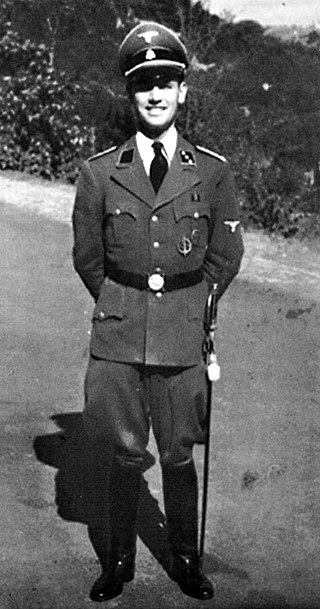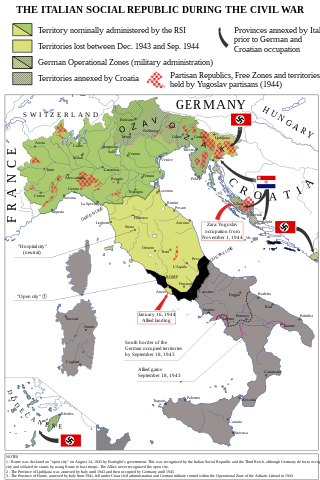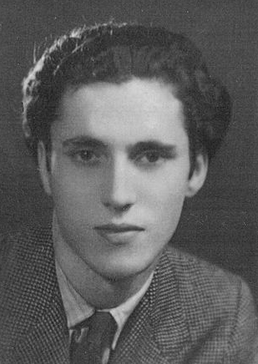
Albert Kesselring was a German military officer and convicted war criminal who served in the Luftwaffe during World War II. In a career which spanned both world wars, Kesselring reached the rank of the Generalfeldmarschall and became one of Nazi Germany's most highly decorated commanders.

Erich Priebke was a German mid-level SS commander in the SS police force (SiPo) of Nazi Germany. In 1996, he was convicted of war crimes in Italy for commanding the unit which was responsible for the Ardeatine massacre in Rome on 24 March 1944 in which 335 Italian civilians were killed in retaliation for a partisan attack that killed 33 men of the German SS Police Regiment Bozen. Priebke was one of the men held responsible for this mass execution. After the defeat of Nazi Germany, he fled to Argentina, where he lived for almost 50 years.

The Ardeatine massacre, or Fosse Ardeatine massacre, was a mass killing of 335 civilians and political prisoners carried out in Rome on 24 March 1944 by German occupation troops during the Second World War as a reprisal for the Via Rasella attack in central Rome against the SS Police Regiment Bozen the previous day.
Karl Hass was an SS Hauptsturmführer and German spy who helped deport more than 1,000 Italian Jews to Auschwitz. A perpetrator in the Ardeatine massacre, in which 335 civilians were murdered, he was tried and convicted in Italy in 1998. He spent the last years of his life under limited house arrest in "the splendour of the beautiful Swiss Alps".

Herbert Kappler was a key German SS functionary and war criminal during the Nazi era. He served as head of German police and security services in Rome during the Second World War and was responsible for the Ardeatine massacre. Following the end of the war, Kappler stood trial in Italy and was sentenced to life imprisonment. He escaped from prison shortly before his death in West Germany in 1978.

Walter Reder was an Austrian SS commander and war criminal during World War II. He served with the SS Division Totenkopf and the SS Division Reichsführer-SS. He and the unit under his command committed the Vinca massacre and Marzabotto massacre in Italy in 1944. After the war, Reder was convicted of war crimes in Italy.

The Scarlet and the Black is a 1983 Italian-American international co-production made-for-television historical war drama film directed by Jerry London, and starring Gregory Peck and Christopher Plummer. Based on J. P. Gallagher's book The Scarlet Pimpernel of the Vatican, the film tells the story of Monsignor Hugh O'Flaherty, a real-life Irish Catholic priest who saved thousands of Jews and escaped Allied POWs in Rome. CBS distributed more than 500,000 scripts of The Scarlet and the Black to students in elementary and high schools throughout the country, to be read aloud in class to stimulate student interest in English and history. The title The Scarlet and the Black is a reference not only to the black cassock and scarlet sash worn by monsignors and bishops in the Catholic Church, but also to the dominant colors of Nazi Party regalia.

Friedrich August Eberhard von Mackensen was a German general and war criminal during World War II who served as commander of the 1st Panzer Army and the 14th Army. Following the war, Mackensen stood trial for war crimes before a British military tribunal in Italy where he was convicted and sentenced to death for his involvement in the Ardeatine massacre, in which hundreds of Italian civilians and political prisoners were shot. The sentence was later commuted and Mackensen was released in 1952. He died in West Germany in 1969.

Massacre in Rome is a 1973 Italian war drama film directed by George Pan Cosmatos about the Ardeatine massacre which occurred at the Ardeatine caves in Rome, 24 March 1944, committed by the Germans as a reprisal for a partisan attack against the SS Police Regiment Bozen. The film was based on the 1967 book Death in Rome by Robert Katz. An Italian court gave producer Carlo Ponti and director Cosmatos a six-month suspended sentence for their film which claimed Pope Pius XII knew of and did nothing about the execution of Italian hostages by the Germans. The charges eventually were dropped on appeal. The names of the victims are shown in the closing credits, as opposed to the cast credits and crew members.

Aldo Finzi was a Jewish-Italian politician and soldier.
Johannes "Hans" Max Clemens was a German functionary of respectively the SS, Sicherheitsdienst was primarily the intelligence service of the SS and the Nazi Party in Nazi Germany. Clemens was also known as the Tiger of Como while serving as a captain in the SS. During the war, he participated in the Ardeatine massacre. Clemens, together with other SS officers, including Herbert Kappler, Karl Hass, Carl-Theodor Schütz, and Erich Priebke, formed the first firing squad, which shot the first 12 victims. After the war, however, Clemens was acquitted of involvement by an Italian military court. He was released and returned to West Germany in 1949.
Paul Hofmann was an Austrian, later American, author, journalist, linguist, and political activist. The New York Times, for whom he was a foreign correspondent, described him as fluent in German, Italian, French, and English, and having a command of several other languages that was more than passable, as well as "a broad grasp of history and diplomatic affairs and an often playful curiosity".

Polizeiregiment "Südtirol", later Bozen, and finally SS-Polizeiregiment "Bozen", was a military unit of the German Ordnungspolizei recruited in the largely ethnic-German Alto Adige region in north-east Italy in late 1943, during the de facto German annexation of the region. The ranks were ethnically German Italian draftees while officers and NCOs were Germans.

The Holocaust in Italy was the persecution, deportation, and murder of Jews between 1943 and 1945 in the Italian Social Republic, the part of the Kingdom of Italy occupied by Nazi Germany after the Italian surrender on 8 September 1943, during World War II.

The raid on the Roman Ghetto took place on 16 October 1943. A total of 1,259 people, mainly members of the Jewish community—numbering 363 men, 689 women, and 207 children—were detained by the Gestapo. Of these detainees, 1,023 were identified as Jews and deported to the Auschwitz concentration camp. Of these deportees, only fifteen men and one woman survived.

The Museum of the Liberation of Rome is located in an apartment building at Via Tasso 145, Rome, close to the basilica of St. John Lateran. It records the period of German occupation of Rome in the Second World War and its subsequent liberation. The building housing the museum was used by the SS to torture members of the Italian Resistance in the first half of 1944.

Two of the three major Axis powers of World War II—Nazi Germany and their Fascist Italian allies—committed war crimes in the Kingdom of Italy.

The Via Rasella attack was an action taken by the Italian resistance movement against the Nazi German occupation forces in Rome, Italy, on 23 March 1944.

Giuseppe Cordero Lanza di Montezemolo was an Italian soldier and Italian Resistance member.

Mario Fiorentini was an Italian partisan, spy, mathematician, and academic, for years a professor of geometry at the University of Ferrara. He engaged in numerous partisan actions, including the assault on the entrance to the Regina Coeli prison and participating in the organization of the attack in via Rasella. He was Italy's most decorated World War II partisan.















